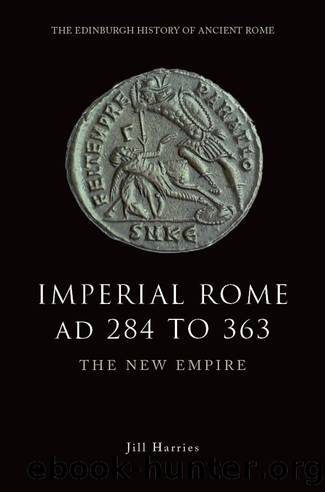Imperial Rome AD 284 to 363 by Harries Jill

Author:Harries, Jill.
Language: eng
Format: epub
Publisher: Edinburgh University Press
The fall of Gallus, 354
Constantius II ruled as Augustus for twenty-four years. Unglamorous in appearance, with a long body and short legs, his profile in ancient and modern historians suffers from Ammianusâ understandable focus on imperial insecurity and court intrigue, along with the emperorâs inability to resolve the high-profile religious controversies of the time, and the more obvious (if also more questionable) attractions of his successor, Julian. Yet the history of Constantius at war, as we shall see, reveals a man with virtues as a ruler unacknowledged by contemporaries obsessed by the search for glory. He safeguarded the frontiers of the empire, while also conserving Roman resources of money and manpower; his policy against Persia was more successful than that of Julian would prove to be. He also survived challenges to his rule, often with little or no bloodshed. In 350, after Constansâ fall, he disposed of Vetranio, briefly proclaimed by the Danube legions, and survived three years of war with Magnentius; in 354, he checked the suspected insubordination of his Caesar Gallus; and in 355, he disposed of a potential rebel, the Frankish-born general Silvanus, by a trick.53
Scheming courtiers feature prominently in Ammianusâ narrative and contributed to the demise of both Gallus and Silvanus, before turning their baleful attentions to Julian.54 Notorious among them was âPaul the Chainâ, so called because of his skill in complicating matters and âlinking togetherâ chains of accusations to entrap his victims.55 He actively pursued the followers of Magnentius, and many fell victims to informants without proper investigations. After the Caesar Gallusâ fall in 354, Paulus again went into action, this time with an equally nefarious associate, Mercurius, the âcount of dreamsâ (comes somniorum), who reported as true the contents of dreams communicated to him by innocent guests at feasts;56 later Paulus re-emerges as an informer on associates of Silvanus,57 before meeting an unlamented end at the hands of Julian.
Ammianus believed that, although individual courtiers were to blame for their own failings, it was Constantius who was responsible for a culture of suspicion. In his concluding assessment of Constantius IIâs virtues and faults as emperor, Ammianus gave pride of place to the emperorâs paranoia:58
Download
This site does not store any files on its server. We only index and link to content provided by other sites. Please contact the content providers to delete copyright contents if any and email us, we'll remove relevant links or contents immediately.
The Daily Stoic by Holiday Ryan & Hanselman Stephen(3264)
The Fate of Rome: Climate, Disease, and the End of an Empire (The Princeton History of the Ancient World) by Kyle Harper(3032)
People of the Earth: An Introduction to World Prehistory by Dr. Brian Fagan & Nadia Durrani(2711)
Ancient Worlds by Michael Scott(2650)
Babylon's Ark by Lawrence Anthony(2649)
The Daily Stoic by Ryan Holiday & Stephen Hanselman(2527)
Foreign Devils on the Silk Road: The Search for the Lost Treasures of Central Asia by Peter Hopkirk(2442)
India's Ancient Past by R.S. Sharma(2432)
MOSES THE EGYPTIAN by Jan Assmann(2395)
The Complete Dead Sea Scrolls in English (7th Edition) (Penguin Classics) by Geza Vermes(2258)
Lost Technologies of Ancient Egypt by Christopher Dunn(2208)
The Earth Chronicles Handbook by Zecharia Sitchin(2204)
24 Hours in Ancient Rome by Philip Matyszak(2065)
Alexander the Great by Philip Freeman(2045)
Aztec by Gary Jennings(1993)
The Nine Waves of Creation by Carl Johan Calleman(1898)
Curse Tablets and Binding Spells from the Ancient World by Gager John G.;(1851)
Before Atlantis by Frank Joseph(1832)
Earthmare: The Lost Book of Wars by Cergat(1806)
